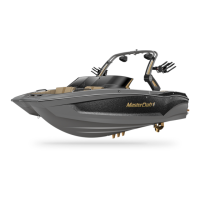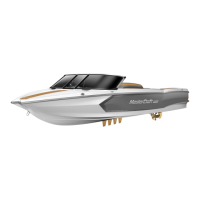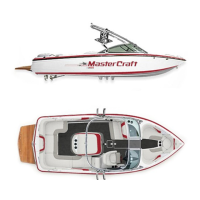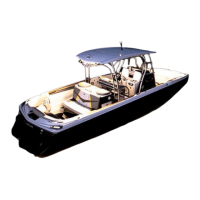Step 4
Run the engine for at least fifteen (15) minutes while in a
body of water. This allows for the circulation of the additives
throughout the fuel system.
During storage, the tank vents can be sealed. If the vent is
sealed, the tank must NOT be completely filled. A ninety-
to-ninety-five percent (90-95%) filled tank allows room for
expansion, which will be required at certain times when
temperatures increase. In addition to preventing water
intrusion, sealing can prevent the gumming that occurs
when the hydrocarbons in gasoline react with naturally
occurring oxygen. This gummy substance plugs up fuel filters
and injectors. Sealing the tank helps reduce gumming by
significantly limiting the amount of oxygen that is allowed
into the fuel tank. If the tank vent is sealed for storage/
winterization, it must be unsealed prior to the boat being
placed back into service. Failure to do so will result in issues
when trying to fill the gas tank in future fill-ups.
Note: Fuel stabilizers work ONLY in fresh gasoline. Stabilizers will
not cure oxygenated gasoline. Adding a stabilizer when the boat is
being prepared for outings after storage will NOT clean the gumming
that has occurred or remove water from the fuel tank or otherwise
eliminate any problems that have occurred due to failure to properly
prepare the fueling system for storage.
Boats that are going to be stored for extended periods (more
than two [2] weeks) or winterized should have the fuel
system treated with stabilizer. Even TOP TIER gasolines will
experience some separation and settling during these periods.
Of considerable concern is that water condensation will occur
within the fuel system. Water is particularly harmful to fuel tanks
and engines, therefore, follow this procedure:
Step 1
The fuel tank should be ninety-to-ninety-five percent (90-95%)
full of TOP TIER gasoline. This allows for minimal room in which
air can oxygenate the fuel during diurnal cycles (daily periods of
expansion/contraction of gasoline vapors and air as a result of
temperature changes).
Step 2
Add a biocide additive in the fuel tank to limit microbial growth
in the gasoline. Follow the directions provided by the additive’s
manufacturer.
Step 3
Add a fuel stabilizer, such as Sta-Bil
®
(preferably the Marine
grade or Ethanol grade stabilizer) to the fuel tank. Follow the
directions provided by the stabilizer’s manufacturer.

